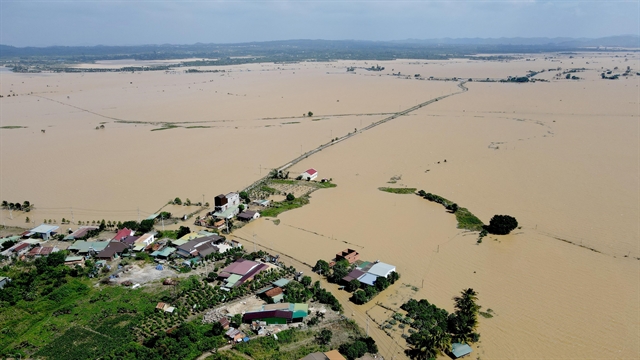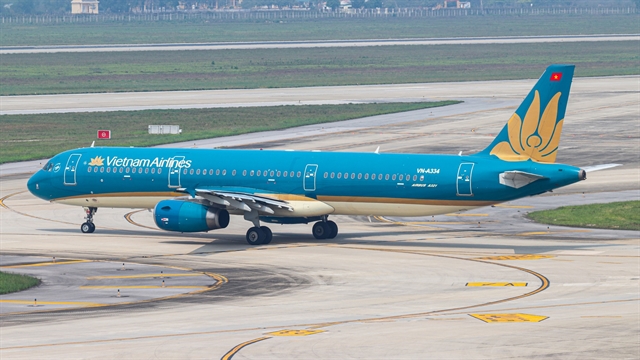 Society
Society

 |
| The temporary bridge built by Ksor Yan crossing the Ba River, connecting Ia Kđăm and Ia Ma Rơn communes in Gia Lai Province. Photos baogialai.com |
GIA LAI – Born and raised on the Ba River, witnessing the danger lurking every time people waded the river back and forth on both sides, for nearly 10 years, a man in Tây Nguyên (Central Highlands) province of Gia Lai spent his own money to build a bridge across the river.
He is Ksor Yan living in Plei Kđăm Hamlet, Ia Kđăm Commune of Ia Pa District, the Gia Lai e-newspaper reported.
After 30 years of rowing boats with his parents to ferry passengers across the Ba River, Yan well understands the hardships people here face because of the lack of direct road access between the two banks.
In 2010, the State invested in building a bridge connecting Ia Kđăm Commune with the district's administrative centre, and his family boating profession gradually faded into the past.
He kept the three boats carefully as souvenirs of the time when his whole family transported guests across the river.
However, because the distance from Ia Kđăm Commune to Ia Ma Rơn Commune is more than 10km when taking the main road to trade local goods and do farming, many people in Chư Mố, Ia Kđăm and Ia Ma Rơn communes still ignored the danger and continued wading across the Ba River to the other bank.
Realising the danger lurking when people wade the river, in 2016, Yan discussed with his family to invest in building a temporary bridge across the river from Plei Kđăm Hamlet in Ia Kđăm Commune to Plei Rngol Hamlet in Ia Ma Rơn Commune.
“There are markets in the communes located east of Ba River, so people have to go to Ia Ma Ron Commune to trade goods,” Yan said.
“Meanwhile, people in Ia Ma Rơn Commune have a lot of arable land located on the east bank of the Ba River,” Yan said.
“Thus, when going to exchange goods or work in the fields, if travelling the main road, people have to go more than 10km from the commune to the district centre, cross the bridge and then turn down,” he explained.
“Meanwhile, if there is a bridge across this river section, the distance is only about 1km, helping people save time,” he said.
He decided to turn his idea into reality.
He asked the local government for permission to build a temporary bridge across the river.
The bridge is more than 300m long made from planks joined together and the foot of the bridge is large wooden posts sunk deep into the river bed.
In spite of efforts to build it securely, when the flood season comes the bridge is swept away by floodwaters.
Yan recalled: “Around June every year, flood waters often rise suddenly at night, so no one can react in time. The water was very strong and the bridge was swept away.”
After the bridge drifted away, he rebuilds it when the river returns to normal level.
“This bridge was newly rebuilt in January,” he said.
 |
| Ksor Yan collecting a fee for crossing the bridge. |
“The whole village joined hands to help. I burned two pigs to worship Yang God and feasted on them. Planks and wood were prepared in advance by my family with a total cost of about VNĐ15 million (US$600),” he said.
Because the bridge has to be rebuilt every year, in order to have funding for maintenance, he charges VNĐ5,000 (20 US cent) for each motorbike crossing, but it is free for bicycles, pedestrians and students.
“The toll is small and is only symbolic, but the main thing is to create conditions for people. If anyone has difficulty, I let them cross the bridge for free,” he said.
Every day about 60 people and vehicles use the bridge and he has to be present from 5am to 5pm.
As a result, the image of the old man in a temporary shack by the river has become familiar to people on both sides of the river for nearly 10 years.
While tending to the bridge, he casts fishing nets into the river.
He said his life was intertwined with the reiver, making it impossible for him to depart.
There were a few times people who drank couldn't control their vehicles and fell into the river, he swam down to help them.
“Thankfully, from the day the bridge was built until now, no unforeseen incident has happened to anyone using the bridge,” he said.
Crossing the river twice a day, Lê Thị Kiều, a resident in Plei Kđăm Hamlet in Ia Kđăm Commune, said: "The commune does not have a market or large grocery store, so every day I have to go to Ia Ma Ron Commune to buy daily necessities for re-selling to the villagers.”
“It was too far on the main road, so I crossed the temporary bridge to save time. At first, I was very nervous, but I got used to it,” Kiều said.
“However, for six months of the year I still have to take the main road because the water rises and washes out the bridge. Everyone wants to have a solid bridge at this location so it will not be blocked during the rainy season,” she said.
Meanwhile, Siu Biên in Ma Rin 2 Village of Ia Ma Rơn Commune, said that his family has two hectares of cassava in Ia Kđăm Commune, so he has to cross the river often to care for it. Every day he takes the temporary bridge to save time.
“The villagers on both sides of the river are very grateful to Yan. In the near future, if he retires, everyone might have to wade through the river again,” Biên said.
Ksor Miên, vice Chairman of the Commune People's Committee Ia Kđăm, said that before building the bridge, Yan asked for permission from the local government, pledging to ensure safety and that the bridge's wood was taken from available materials, not cut down from the forest.
During the rainy and flood season, the local government posts signs warning people of the danger, Miên said.
Many times, the local people petitioned the authority to build more solid bridges in this area. But because of the funding required, there has been no more solid bridge built, he said.
Yan said sadly: "I will probably only be able to rebuild the bridge this year. I am old and have pains all over my body; next year I won’t be able to do it anymore.”
“I just hope the State invests in more solid bridges to help people ease their hardships," he said. VNS




